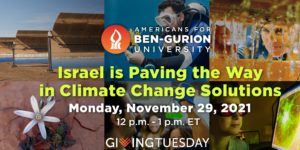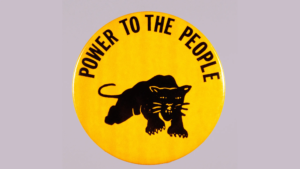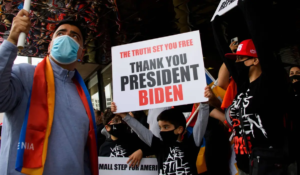A Professor’s Statement on the Unfolding Situation at Columbia University
As a member of the Columbia University community for over 30 years, Director of the Morton Deutsch International Center for Cooperation and Conflict Resolution, current member of the University’s Task Force on Antisemitism, and a student of intractable conflict and sustainable peace, I felt it incumbent on me to share my take on the extraordinary challenges facing our community today.
For context, I have studied, written and wondered about the many conflicts related to Israel and the Palestinian territories for decades. I have visited and conducted research on peacebuilding in the region on several occasions, writtenabout how the conflicts there have manifested at Columbia University in the past, and have traveled through the West Bank, including Hebron, Bethlehem, Ramallah, and Nablus. I have not been to Gaza to date, although one of my top students, Naira Musallam, a Palestinian-Israeli, conducted her dissertationresearch there in 2010. I was last in Israel in May 2023 working with Israeli, Palestinian and international students through the Harry S. Truman Research Institute for the Advancement of Peace at Hebrew University (I later posted this blog on my experiences), and hope to return there this summer to continue this crucial work.
When I first visited the West Bank, I had a revelation. Some UN colleagues and I were traveling South out of Bethlehem towards Hebron on a dusty road, when we began to pass countless miles of a dilapidated refugee camp on our left (I believe it was Dheisha). This was one of the many camps where Palestinians who had fled Israel in 1948 had settled, and who still today refuse most support from the Israeli government as an active act of protest against the normalization of their ouster and a political statement signifying their struggle.
After passing by several miles of the ramshackle camp, I noticed on the right side of the road that a new, well-constructed municipality had been built, which in comparison to the camp looked like a nice suburb outside Cleveland. When I asked my colleagues about these structures, they explained to me that they had been built and were supported by the Israeli government, with running water, electricity, and sanitation. They also explained that at some point, many families from the refugee camp, desperate from the conditions they had lived in, chose to cross the road and set up home in the new buildings. However, doing so was typically seen as an unforgivable betrayal of the struggle by members of their family and community that stayed behind, who often disparaged them or cut ties with them altogether. This was just another glimpse into the complex web of multiple intertwined conflicts and moral dilemmas which constitute what many of us call the “Israeli-Palestinian conflict.”
So, as I have walked through campus and witnessed the escalating protests and attended faculty panels and heard some of the heated, overly-simplistic sloganeering coming from the speakers over the current situation in Israel and Gaza, which have permeated and encircled our campus at Columbia of late, and as I have sat in listening sessions with students and faculty harmed by these events, the following statement has often come to mind, which was offered by a Palestinian physicist at Columbia for a study we conducted in the midst of the 2002 Intifada in Palestine and Israel. She said,
“One of the things that frustrates me about this conflict, thinking about this conflict, is that people don’t realize the complexity… how many stakeholders there are in there…I think there is a whole element to this particular conflict to where you start the story, to where you begin the narrative, and clearly it’s whose perspective you tell it from…One of the things that’s always struck me is that there are very compelling narratives to this conflict and all are true, in as much as anything is true… I think the complexity is on so many levels…It’s a complexity of geographic realities…the complexities are in the relationships…it has many different ethnic pockets… and I think it’s fighting against a place, where particularly in the United States, in American culture, we want to simplify, we want easy answers…We want to synthesize it down to something that people can wrap themselves around and take a side on…And maybe sometimes I feel overwhelmed…”
Of course, this statement is also true.
However, holding onto such a nuanced perspective, such wisdom, or especially expressing it publicly, is extremely difficult today — treacherous, exhausting, overwhelming. Especially given the extreme violence grinding on in Palestine and Israel, the real acts of intimidation, provocation, and assault happening on our campus, the blatant denial of these acts, and the pervasiveness of extreme one-sided narratives that are filling our discourse. This is a time when we all feel pulled, in fact required, to take a clear moral stand on the situation, but often this requires us to over-simplify what are terribly messy issues.
So, in a small attempt to provide some context for these events, allow me to lay out some of the layers of this current crisis to aid those who stive to hold onto its inherent complexities, contradictions and dilemmas.
First, we are in a crisis. The current firestorm at Columbia is real, painful and deeply concerning. It was triggered most recently by the horrific combination of the slaughter, rape and kidnapping of Israeli civilians by Hamas militants on October 7, 2023, and by the Israeli government’s violent, punishing and unrelenting response to Palestinians and its deadly effects on humanitarian workers, journalists and many others in Gaza.
But the crisis at Columbia is also playing out in the context of dramatic spikes in antisemitism and anti-Muslim hate across the U.S., which preceded but were exacerbated by the current war, by the politicization and weaponization of these trends by members of the U.S. Congress who seek to delegitimize “elite” institutions of higher education like Columbia for political gain, and in the wake of 60 years of pernicious political polarization in the U.S. where we are seeing increasing tolerance for acts of political violence — as we head into what is likely to be the most contested elections in our nation’s history.
Further out, our crisis is also fueled daily by the atrocious violence playing out in the Middle East — by the dogged intransigence of Hamas and its supporters during “negotiations” over a ceasefire, their depraved willingness to sacrifice the lives of Gazan’s for their cause, and proud declarations by Hamas’ leaders of their ultimate goal to destroy the nation of Israel “from the river to the sea.” Of course, to some degree, these actions are both reactions to and justifications for the violent, aggressive, militant, expansionist policies of the far-Right Netanyahu government in Israel who for decades have shown scant interest in securing a genuine Israeli-Palestinian peace and whose support amongst the Israeli population at home has plummeted.
Nevertheless, how the Columbia community has responded to these tragic events is also a reflection of the current culture at Columbia and the lack of a sufficient infrastructure for de-escalation and peacemaking in such difficult times. As I wrote last fall, it is no accident that Columbia has served as the epicenter of the current cascade of crises spreading across college campuses in America. New York City’s large Jewish population and insatiable media apparatus make Columbia a magnet for national media attention on this conflict, and therefore a prime target for outside agitators who seek to weaponize the crisis in Israel to their own political advantage. In fact, Columbia also has a long, troubled history of deep divisions over the conflicts in Israel/Palestine, which have been ignited before on campus — most notably during the last Intifada from 2000–2005, events that were also fueled by outside groups.
Then, there are the deeper cultural challenges within Columbia. The University has a long, proud tradition of political activism, going back to the student protests of the Vietnam war in the 1960s and Apartheid in South Africa in the 1980s. This legacy has tended to attract administrators, faculty and students aligned with a more progressive, activist agenda. This, of course, can be constructive, unless it breeds a Liberal form of intolerance.
Last September, I published an opinion in the Columbia Spectator over concerns about Columbia’s poor rankings in the Foundation for Individual Rights and Expression (FIRE) report on free speech on college campuses, and the consequences of this for political intolerance in our community. This type of illiberal culture makes us particularly susceptible to quick, extreme, over-simplified reactions by members of our student and faculty community to highly-complex and fluid situations, such as those unfolding in Israel and Gaza — and at the University — today. These conditions encourage rapid mobilization to protest, but often without the necessary precursor to effective activism: critical reflection on the dilemmas inherent to our positions, the broader context of events, and the possible unintended consequences of our strategies.
Add to this the ripeness of the current student body for political mobilization. Of course, this is nothing new for college campuses, especially at Columbia. But the current “anxious generation” on campus, which researchsuggests — thanks to the COVID crisis, helicopter parenting, an acute addiction to screens and social media, and the concomitant social fragmentation on campuses — are feeling especially stressed, isolated, lonely, and disengaged. This makes them particularly susceptible to recruitment to a cause; to issues and groups that offer a sense of purpose and belonging.
Finally, this constellation of drivers of political instability have been playing out at Columbia during a time of critical leadership transition. President Shafik first joined Columbia last July, replacing Lee Bollinger who had served for 20 years as president. Shafik, along with having an interim Provost, walked immediately into a roiling crisis at the Medical School over a decades-long sexual abuse scandal, in addition to the challenge of overhauling DEIA initiatives across the campuses in the context of the U.S. Supreme Court’s recent decision restricting race-conscious affirmative action in college admissions. Then, the October 7th attacks detonated tensions on campus, and the resulting spike in antisemitism resulted in Shafik and other University Presidents being called before congress, two of whom were subsequently forced to resign (due to a scheduling conflict, Shafik didn’t appear before Congress until April 2024). This series of crises set the context for the recent decisions that our new President was forced to make regarding faculty and student divisions, bias accusations, free speech protections, protests, punishments, and campus security.
So, here we are.
What should Columbia do to navigate through this storm? There are a host of changes and new initiatives that will be required to right the ship at the University. In fact, the main mandate of our task force — and other such groups currently working across campus — is to offer actionable recommendations to university leadership to fight and prevent hate in all its forms. But, in addition, I suggest the following:
First, I suggest that we begin by ensuring a safe, celebratory graduation experience for our 2024 COVID-19 class (my task force colleagues and I have called for negotiating a community compact around this). This would be a much-needed respite for our students and faculty.
Next, we need to take the summer to reset. The University should take the time to convene its best minds to fashion a comprehensive plan on 1) what is already functioning well to prevent and mitigate hate on campus and 2) what substantive changes need to happen to reduce the odds of this happening again. This should begin by identifying the current network of trusted members of the community — clergy, coaches, RAs, deans, student leaders, ombuds, mediators, and so on — and then gathering and listening to them about what specifically needs to happen today and in the near future at CU. It should also involve connecting with the many other campuses across the country — those struggling with these issues and those who seemed to have managed it well — to gain lessons learned.
Ultimately, this work will require both short-term and sustained longer-term actions. Of course, the administration must continue to prioritize ensuring physical, psychological and cyber safety and security for the entire community — while simultaneously ensuring free speech at reasonable times and places for all. This is no simple matter, but this first report of the Antisemitism task force offers some guidance on how this can be accomplished. The administration must also remain in frequent communication with all stakeholders at Columbia regarding these issues, including students, faculty, staff, parents, alumni, and the media.
However, in the longer-term, Columbia needs to work actively to grow a new culture that privileges belonging, anti-bias and free speech — andprovides the skills, rules, norms and procedures that allow these virtues to be managed constructively. This typically happens over time by intentionally changing the socialization processes (orientation and onboarding) for new members, especially faculty, students, and staff, and ensuring that university leadership at all levels model and reward civil and critical discourse. It is also essential that Columbia establish a more robust infrastructure for peacemaking and peacebuilding on campus — with trusted, well-trained community facilitators — who are prepared to step in when new crises erupt — because they will.
Most importantly, what should we, the members of the Columbia community, do now? Honestly, I struggle with this constantly. Do I choose to stand in solidarity with the desperate, deplorable plight of Palestinians in Gaza and elsewhere in the region, or help others to recognize the impossible security situation faced by Israelis when Hamas, Iran and their proxies brazenly seek their extermination? Do I speak out for the inalienable rights of students and faculty to protest and express even inflammatory versions of their political views against Israel on campus, or do I prioritize protecting the safety, security and dignity of the Jews in our community being harmed by these words and deeds? Do I redouble my efforts to teach tolerance, peace and constructive conflict resolution, or simply give up, throw off the gloves, march and fight for what I feel in my heart is morally right and salient — at least in this moment? These are just some of the moral dilemmas that keep me up at night.
Peter T. Coleman is a professor of psychology and education at Columbia University and the author most recently of The Way Out: How to Overcome Toxic Polarization.




